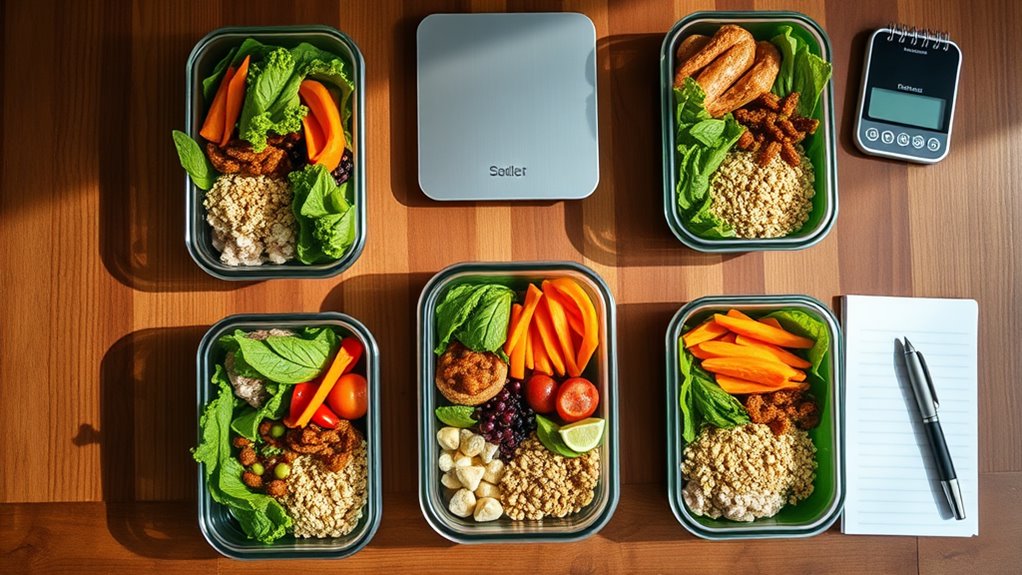How to Build a Weekly Diet That Actually Works
Building a weekly diet that actually works starts with understanding your unique needs and goals. By keeping a food diary, you can identify what works for you and what doesn’t. Planning balanced meals is crucial, as is incorporating variety and seasonal ingredients to keep things interesting. But there’s more to it than just that. Let’s explore how you can create a sustainable eating plan that fits your lifestyle and leads to real results.
Key Takeaways
- Assess your dietary needs, preferences, and activity level to create a tailored meal plan that aligns with your health goals.
- Track your food intake with a diary to identify nutritional gaps and adjust your diet accordingly.
- Plan balanced meals incorporating a variety of whole foods, emphasizing seasonal produce for flavor and nutrients.
- Prepare a weekly shopping list focused on whole foods, and practice batch cooking to save time and ensure fresh meals.
- Monitor your progress weekly, adjusting your diet based on weight loss, energy levels, and meal variety feedback.
Assess Your Dietary Needs and Goals
How can you determine what your body truly needs?
Start by assessing your dietary preferences, activity level, and health goals.
Use a food diary to track what you eat and how it makes you feel.
This’ll help you identify patterns and gaps in your nutrition.
Incorporating meal planning tips, like prepping meals in advance and focusing on whole foods, can ensure you meet your needs.
Don’t forget to consider portion sizes and balance among food groups.
Consulting a registered dietitian can also provide personalized insights, helping you to design a diet that supports your unique lifestyle and objectives effectively. Additionally, integrating sustainable meal planning practices can enhance both your health and environmental impact.
Plan Balanced Meals
When planning your meals, understanding macronutrient distribution is vital for meeting your health goals. Aim to incorporate a variety of foods daily, as this not only keeps your meals interesting but also ensures you’re getting a broad range of nutrients. Balanced meals will help sustain your energy levels and support overall well-being. Additionally, focusing on portion sizes can help you maintain a healthy weight while still enjoying a diverse diet.
Macronutrient Distribution Importance
Why is macronutrient distribution crucial for your weekly diet?
It’s the foundation for achieving your health and fitness goals.
Balancing protein, fats, and carbohydrates ensures you fuel your body efficiently.
Here are three key benefits:
- Energy Levels: A proper mix keeps your energy stable throughout the day.
- Muscle Maintenance: Adequate protein supports muscle repair and growth, especially if you’re active.
- Weight Management: Balancing macros helps control hunger and cravings, making it easier to stick to your diet.
Incorporate Variety Daily
Are you wondering how to keep your meals exciting while still meeting your dietary goals? Incorporating variety daily is key.
Aim to include different protein sources, such as chicken, fish, and plant-based options. Rotate your vegetables, too; each offers unique nutrients.
Experiment with whole grains like quinoa, brown rice, and barley to keep carbs interesting. Don’t forget healthy fats from avocados, nuts, and olive oil.
Planning balanced meals not only satisfies your taste buds but also prevents nutrient deficiencies. By mixing up your meals, you’ll stay motivated and on track, ultimately making your diet more sustainable and enjoyable.
Incorporate Variety and Seasonal Ingredients
Incorporating variety and seasonal ingredients is key.
Seasonal produce not only tastes better but also offers more nutrients.
Here are three simple ways to embrace this approach:
- Visit Local Farmers’ Markets: Fresh, seasonal ingredients are often more flavorful and nutrient-dense.
- Try New Recipes: Experiment with different cuisines that highlight seasonal foods, keeping your meals exciting.
- Plan Around Seasonal Ingredients: Base your week’s meals on what’s in season to ensure freshness and variety.
Additionally, consider adding nutrient-dense superfoods to your meals, as they are affordable and can enhance your diet without stretching your budget.
Create a Weekly Shopping List
What’s the best way to ensure you stay on track with your weekly diet?
Creating a shopping list tailored to your meal plan is key.
Start by outlining your meals for the week, including breakfast, lunch, dinner, and snacks.
Identify the ingredients you need, focusing on whole foods like fruits, vegetables, lean proteins, and whole grains.
Stick to your list when shopping to resist impulse buys.
Research shows that planning your meals and shopping list can significantly improve dietary adherence.
Keep your list handy on your phone or a notepad, and you’ll find it easier to stay committed to your goals. Incorporating whole food nutrition into your diet can enhance your overall health by providing essential nutrients more effectively than supplements.
Prepare and Store Meals Efficiently
To make the most of your meal prep, you need to focus on the essentials that simplify your cooking process.
Smart storage solutions can keep your meals fresh and organized, while efficient reheating techniques ensure you enjoy them without hassle. Incorporating whole foods into your meal prep not only enhances flavor but also supports your body’s natural detoxification processes.
Let’s explore how these strategies can save you time and help you stick to your weekly diet plan.
Meal Prep Essentials
Effective meal prep is a game changer for anyone looking to maintain a balanced diet while saving time during the week.
To get started, focus on these essentials:
- Containers: Invest in high-quality, airtight containers to keep your meals fresh and organized.
- Batch Cooking: Cook large portions of grains, proteins, and veggies at once. This saves cooking time and helps you mix and match throughout the week.
- Labels: Use labels to mark dates and contents, ensuring you know what’s in each container and when it was made.
With these essentials, you’ll streamline your meal prep and stay on track with your dietary goals.
Smart Storage Solutions
How can you maximize the freshness of your meals while keeping your fridge organized?
Start by using clear, airtight containers for meal storage. Label each container with the contents and date to avoid confusion.
Group similar items together, placing proteins on the top shelf and veggies in the crisper. Use a FIFO (first in, first out) approach to consume older meals first.
Invest in stackable containers to save space and prevent clutter. Regularly check for expired items and remove them promptly.
These smart storage solutions not only maintain your meal quality but also streamline your weekly diet preparation process.
Efficient Reheating Techniques
Ever wondered what the best ways to reheat your meals are for optimal flavor and texture? Efficient reheating can make all the difference. Here are three techniques to enhance your leftovers:
-
Microwave with a Damp Paper Towel: Cover your food with a damp paper towel to retain moisture and prevent drying out.
-
Oven for Crispy Texture: Preheat your oven to 350°F (175°C) for even heating, especially for baked goods or proteins.
-
Stovetop for Saucy Dishes: Reheat on low heat, stirring occasionally to maintain consistency without burning.
These methods keep your meals delicious and enjoyable!
Track Progress and Make Adjustments
Are you keeping an eye on your progress as you follow your weekly diet? Monitoring your results is crucial for success. Regularly assess how you feel, your energy levels, and any changes in weight or measurements. If you’re not seeing desired results, don’t hesitate to adjust your meal plan or exercise routine. It’s also important to be aware of hidden calories that can sneak into your diet and hinder your weight loss efforts.
| Week | Weight Change | Notes |
|---|---|---|
| 1 | -2 lbs | Felt more energetic |
| 2 | 0 lbs | Need to increase protein |
| 3 | -1 lb | Cravings decreased |
| 4 | -3 lbs | Review meals for variety |
This structured approach can help guide your adjustments effectively.


